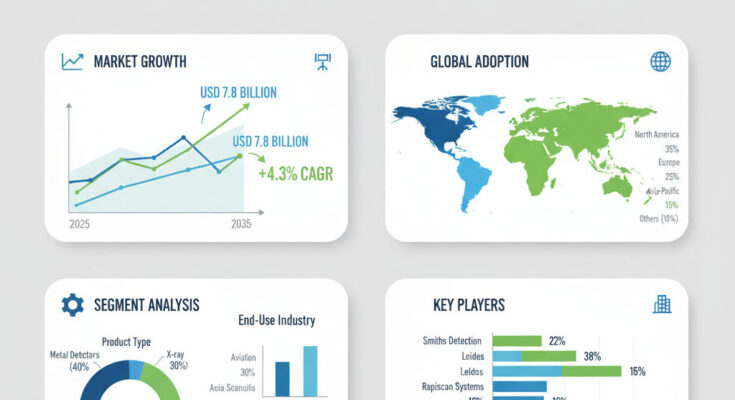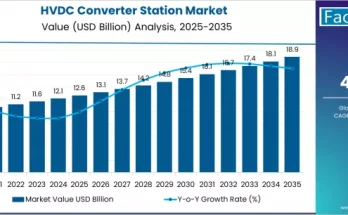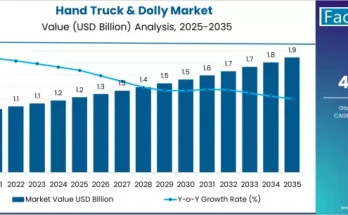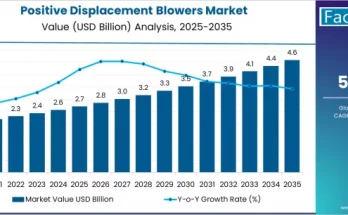The global security detectors and scanners market is entering a phase of steady and sustained growth. The market is projected to expand from approximately USD 7.8 billion in 2025 to about USD 11.9 billion by 2035, representing a compound annual growth rate (CAGR) of about 4.3% over the the ten-year period. This trajectory is driven by rising global security threats, expanding transportation and infrastructure screening needs, modernization of detection technologies, and increasing regulatory mandates for threat detection across public and private sectors.
Market Drivers and Growth Catalysts
A number of key factors are fueling expansion in this market. Global security concerns such as terrorism, smuggling of contraband, weapons, and illicit materials are pushing governments and private operators to upgrade detection infrastructure. Airports, border crossings, rail stations, logistics hubs, and public buildings are increasingly deploying advanced scanners to detect explosives, weapons, narcotics, or other threats. The growing flow of passengers, freight, and travelers creates volume pressure for screening systems.
Technological innovation is also a major driver. Advanced detection systems now integrate X-ray imaging, computed tomography, metal detection, and explosive trace detection. Many systems are adding AI-guided image analysis, automatic threat recognition, and integration with larger security management platforms. These improvements increase screening throughput, reduce false alarms, and give operators more actionable intelligence.
There is also regulatory pressure and industry standardization. Authorities in many countries require stricter screening in airports, cargo checkpoints, government facilities, and critical infrastructure. Compliance with these mandates pushes operators to adopt certified, high-performance detection equipment to meet threat detection standards and maintain safety.
Segmentation: Products, Technologies, Applications
When segmenting by product or detection type, X-ray detection systems are expected to remain dominant, capturing a significant portion of the the market share (in the order of ~45%) due to their utility in scanning baggage, cargo, and people for concealed items. Metal detector systems also hold a meaningful share especially in walk-through screening or controlled entry points. Other detection systems like explosive / chemical trace detectors, radiation detectors, or dual-technology scanners contribute to the broader detection ecosystem.
By application, airport security screening is the largest end use segment, accounting for a substantial proportion of demand. The high volume of passenger and baggage screening, combined with regulatory mandates, makes airports a core market. Over the decade, growth will also be driven by logistics hubs, commercial building security, border control and critical infrastructure protection.
Portable and mobile scanners / detectors are growing in demand as well, enabling flexible screening at events, temporary checkpoints, or logistics checkpoints. The shift toward integrated security systems means that detectors and scanners are becoming part of broader security networks rather than standalone devices.
Regional Trends & Market Outlook
Regionally, North America remains a mature and leading market for security scanning and detection equipment. The region benefits from strong regulatory frameworks, advanced technology adoption, and robust public infrastructure investments in airports, border security, and other high-security facilities. Operators in North America tend to adopt premium, high performance, and AI-integrated detection platforms.
Europe is also a major region, supported by stringent security regulations, established screening infrastructure, and rising concerns about mixed threats in public and transportation sectors. Many European countries are accelerating upgrades to scanning technologies and integrating them with cross-border security networks.
Asia-Pacific is one of the fastest growing regions for detectors and scanners. Rapid expansion of airports, cross-border trade, freight volumes, and large infrastructure projects drive demand for screening solutions. Emerging economies are investing heavily in security systems for airports, customs, and border checkpoints, and are adopting modern detection technologies to meet global safety standards.
Other regions such as Latin America, Middle East & Africa are also increasing investments in security detection infrastructure due to rising public safety concerns, rising terrorism risk, and modernization of ports, airports, and critical infrastructure.
Competitive Landscape & Key Players
The competitive landscape is comprised of major detection equipment manufacturers, specialist scanning system providers, and integrated security technology firms. Leading companies in the this space are known for developing advanced detection hardware, imaging systems, and analytic software solutions. These players compete on detection performance, throughput speed, false alarm reduction, portability, integration capabilities, regulatory certification, and after-sales support.
Manufacturers are also expanding capacity, improving product design, and offering bundled solutions that include scanners, control software, threat analytics, and maintenance services. Many are investing in research to improve detection algorithms, integrate AI/ML for threat recognition, and enhance portability for mobile / field detection.
Challenges and Market Constraints
Despite favorable prospects, the market faces some constraints. The high cost of advanced scanning systems can be a barrier for smaller facilities or events with limited budget. Upgrading from legacy or manual detection systems requires capital investment, training, and integration with existing security platforms.
Technical challenges also persist. Ensuring accurate detection with minimal false alarms is critical. Balancing sensitivity with throughput (so as not to create delays) is a design challenge. Portable or mobile detectors must maintain reliability under field conditions.
Further, regulatory and certification requirements vary across countries. Different standards may apply for radiation safety, imaging, data privacy in full-body scanning, or trace detection of chemicals / explosives. Compliance with multiple standards may slow rollout or increase development costs.
Forecast & Strategic Recommendations
Looking ahead to 2035, the market for security detectors and scanners is expected to grow from USD 7.8 billion in 2025 to about USD 11.9 billion, driven by infrastructure upgrades, airport expansions, logistics screening needs, and rising security concerns. To succeed in this evolving market, manufacturers and integrators should:
-
Invest in AI and analytics integration to improve accuracy and reduce false positives.
-
Develop portable / mobile detection units for flexible deployment in events, border crossings, or temporary checkpoints.
-
Expand regional presence in high-growth markets such as Asia-Pacific, Latin America, and the Middle East.
-
Provide full solutions: equipment + software + maintenance + training + regulatory compliance support.
-
Maintain certification & compliance with global and regional detection standards to facilitate cross-border deployment.
Browse Full Report: https://www.factmr.com/report/security-detectors-and-scanners-market
Editorial Perspective
Security detection equipment and scanners are no longer just tools — they are strategic assets in a world facing evolving threats. The next decade will see these devices become smarter, faster, more integrated, and more portable. Organizations looking to secure airports, freight hubs, public venues, or events will rely on advanced detection systems not only to identify threats but to manage and analyze security data in real time.
Companies that can deliver high-performance, compliant, and integrated detection solutions will lead the market. The period to 2035 represents both a commercial opportunity and a critical mission for global security infrastructure.



